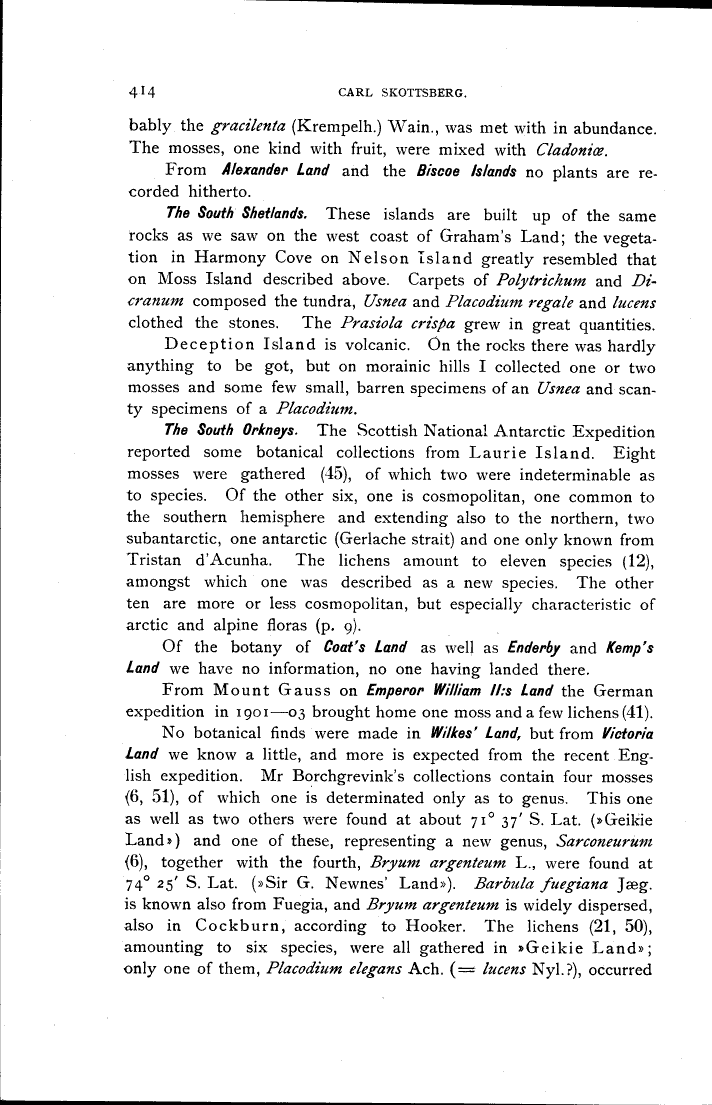
Full resolution (TIFF) - On this page / på denna sida - Some remarks upon the geographical distribution of vegetation in the colder Southern Hemisphere. By Carl Skottsberg. Botanist of the Swedish Antarctic Expedition 1901—1903. With 2 maps, tabl. 8 and 9. - General survey of the austral of or palæooceanic (Engler) realm. - I. The antarctic dominion.

<< prev. page << föreg. sida << >> nästa sida >> next page >>
Below is the raw OCR text
from the above scanned image.
Do you see an error? Proofread the page now!
Här nedan syns maskintolkade texten från faksimilbilden ovan.
Ser du något fel? Korrekturläs sidan nu!
This page has never been proofread. / Denna sida har aldrig korrekturlästs.
4-14 CARL SKOTTSBERG.
bably the gracilenia (Krempelh.) Wain., was met with in abundance.
The mosses, one kind with fruit, were mixed with Cladonio.
From Alexander Land and the Biscoe Islands no plants are
recorded hitherto.
The South Shetlands. These islands are built up of the same
rocks as we saw on the west coast of Graham’s Land; the
vegetation in Harmony Cove on Nelson Island greatly resembled that
on Moss Island described above. Carpets of Polytrichum and
Di-cranum composed the tundra, Usnea and Placodium regale and lucens
clothed the stones. The Prasiola crispa grew in great quantities.
Deception Island is volcanic. Ön the rocks there was hardly
anything to be got, but on morainic hills I collected one or two
mosses and some few small, barren specimens of an Usnea and
scanty specimens of a Placodium.
The South Orkneys. The Scottish National Antarctic Expedition
reported some botanical collections from Laurie Island. Eight
mosses were gathered (45), of which two were indeterminable as
to species. Of the other six, one is cosmopolitan, one common to
the southern hemisphere and extending also to the northern, two
subantarctic, one antarctic (Gerlache strait) and one only known from
Tristan d’Acunha. The lichens amount to eleven species (12),
amongst which one was described as a new species. The other
ten are more or less cosmopolitan, but especially characteristic of
arctic and alpine floras (p. 9).
Of the botany of Coat’s Land as well as Enderby and Kemp’s
Land we have no information, no one having landed there.
From Mount Gauss on Emperor William //:s Land the German
expedition in 1901-03 brought home one moss anda few lichens(41).
No botanical finds were made in Wilkes’ Land, but from Victoria
Land we know a little, and more is expected from the recent
English expedition. Mr Borchgrevink’s collections contain four mosses
(6, 51), of which one is determinated only as to genus. This one
as well as two others were found at about 71° 37’ S. Lat. (»Geikie
Land») and one of these, representing a new genus, Sarconeurum
{6), together with the fourth, Bryum argenteum L., were found at
74° 25’ S. Lat. (»Sir G. Newnes’ Land»). Barbula fuegiana Jæg.
is known also from Fuegia, and Bryum argenteum is widely dispersed,
also in Cockburn, according to Hooker. The lichens (21, 50),
amounting to six species, were all gathered in »Geikie Land»;
only one of them, Placodium elegans Ach. (= lucens Nyl.?), occurred
<< prev. page << föreg. sida << >> nästa sida >> next page >>